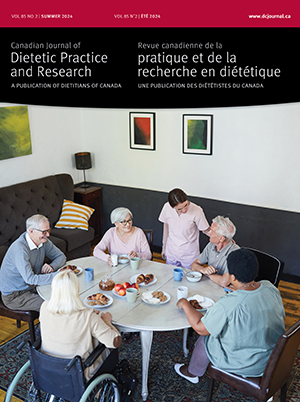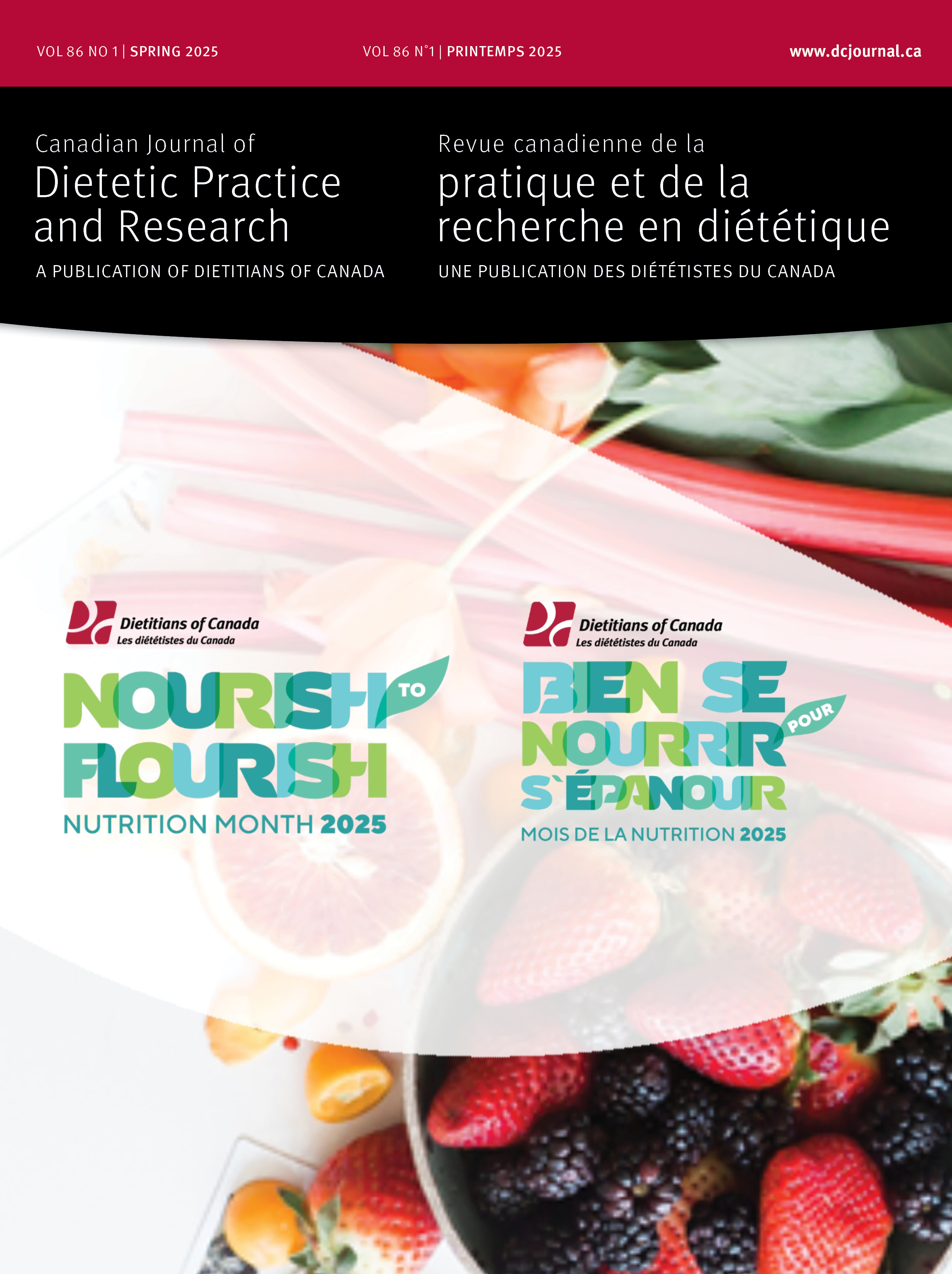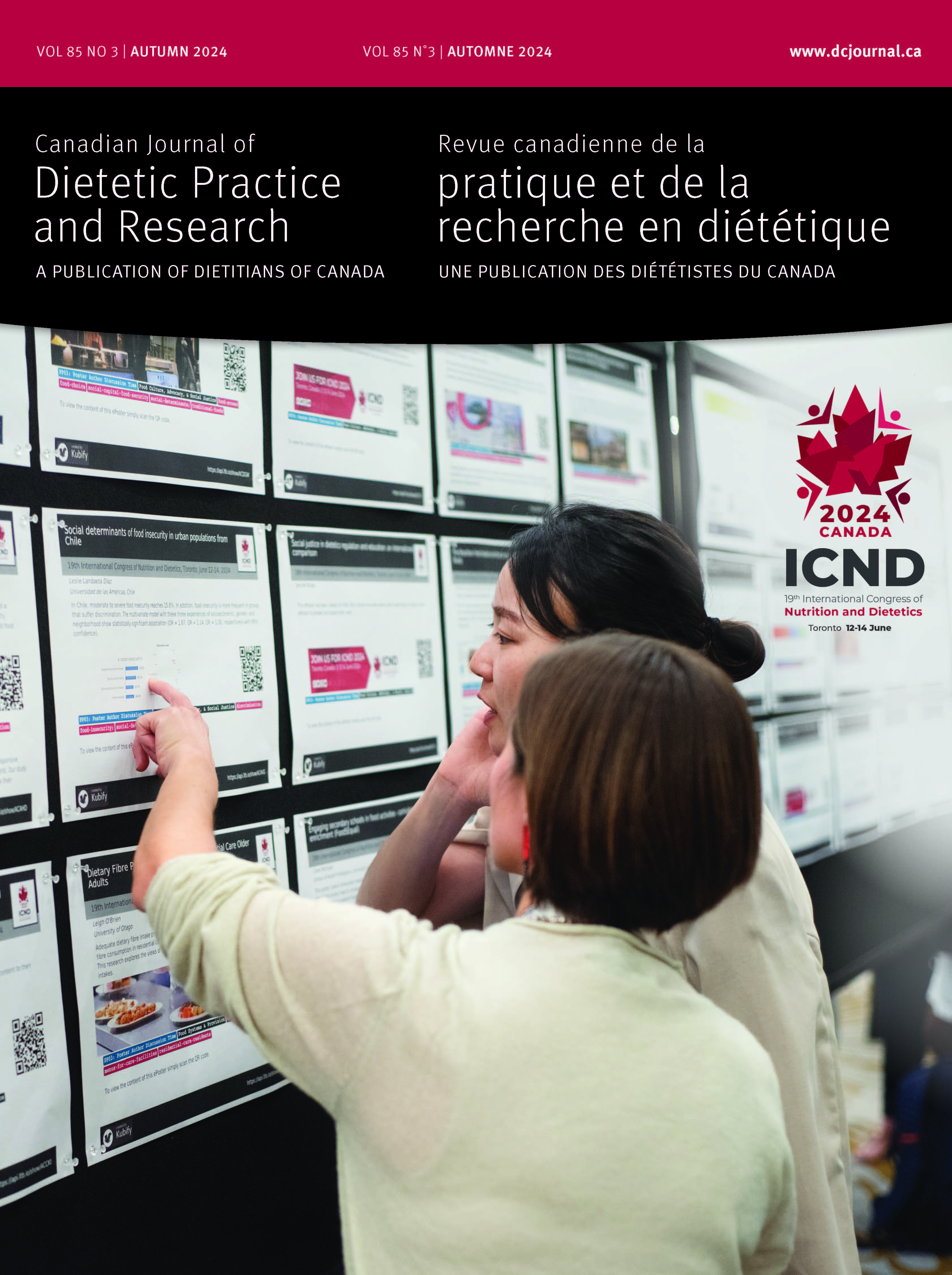Volume 85 • Number 2 • June 2024
Editor’s Message
Research
OPEN ACCESS
Purpose: This study aimed to assess the reliability and validity of an online approach to monitoring food affordability in Ontario using the updated Ontario Nutritious Food Basket (ONFB).Methods: The ONFB was priced online in 12 large multi-chain grocery stores to test intra-/inter-rater reliability using percent agreement and intra-class correlations (ICCs). Then, the ONFB was priced in-store and online in 28 stores to estimate food price differences using paired t-tests and Pearson’s correlation for all (n =1708) and matched items (same product/brand and purchase unit) (n = 1134).Results: Intra-/inter-rater agreement was high (95.4%/81.6%; ICC = 0.972, F = 69.9, p < 0.001). On average, in-store prices were less than $0.02 lower than online prices. There were no significant differences between mean in-store and online prices for all items (t = 0.504 p = 0.614). The mean price was almost perfectly correlated between in-store and online (fully matched: R = 0.993 p < 0.001; all items: R = 0.967 p < 0.001). Online monthly ONFB estimates for a family of four were strongly correlated (R = 0.937 p < 0.001) with estimates calculated using in-store data.Conclusions: Online pricing is a reliable and valid approach to food costing in Ontario that contributes to modernizing the monitoring of food affordability in Canada and abroad.
Purpose: To assess care home and staff characteristics associated with task-focused (TF) and relationship-centred care (RCC) mealtime practices prior to the COVID-19 pandemic.Methods: Staff working in Canadian and American care homes were invited to complete a 23-item online survey assessing their perceptions of mealtime care, with one item assessing 26 potential care practices from the Mealtime Relational Care Checklist (relationship-centred = 15; task-focused = 11) reported to occur in the home prior to the pandemic. Multivariate linear regression evaluated staff and care home characteristics associated with mealtime practices.Results: Six hundred and eighty-six respondents completed all questions used in this analysis. Mean TF and RCC mealtime practices were 4.89 ± 1.99 and 9.69 ± 2.96, respectively. Staff age was associated with TF and RCC practices with those 40–55 years reporting fewer TF and those 18–39 years reporting fewer RCC practices. Those providing direct care were more likely to report TF practices. Dissatisfaction with mealtimes was associated with more TF and fewer RCC practices. Homes that were not making changes to promote RCC pre-pandemic had more TF and fewer RCC practices. Newer care homes were associated with more RCC, while small homes (≤49 beds) had more TF practices.Conclusions: Mealtime practices are associated with staff and home factors. These factors should be considered in efforts to improve RCC practices in Canadian homes.
Indigenous Identity and Household Food Insecurity are Associated with Poor Health Outcomes in Canada
Purpose: To examine whether Indigenous identity and food insecurity combined were associated with self-reported poor health.Methods: Data from the 2015–2016 Canadian Community Health Survey and multiple logistic regression were employed to evaluate the association between Indigenous identity, household food insecurity, and health outcomes, adjusted for individual and household covariates. The Alexander Research Committee in Alexander First Nation (Treaty 6) reviewed the manuscript and commented on the interpretation of study findings.Results: Data were from 59082 adults (3756 Indigenous). The prevalence of household food insecurity was 26.3% for Indigenous adults and 9.8% for non-Indigenous adults (weighted to the Canadian population). Food-secure Indigenous adults, food-insecure non-Indigenous adults, and food-insecure Indigenous adults had significantly (p < 0.001) greater odds of poor health outcomes than food-secure non-Indigenous adults (referent group). Food-insecure Indigenous adults had 1.96 [95% CI:1.53,2.52], 3.73 [95% CI: 2.95,4.72], 3.00 [95% CI:2.37,3.79], and 3.94 [95% CI:3.02,5.14] greater odds of a chronic health condition, a chronic mental health disorder, poor general health, and poor mental health, respectively, compared to food-secure non-Indigenous adults.Conclusions: Health policy decisions and programs should focus on food security initiatives for all Canadians, including addressing the unique challenges of Indigenous communities, irrespective of their food security status.
Purpose: To examine the social network factors associated with changes in nutrition risk scores, measured by SCREEN-8, over three years, in community-dwelling Canadians aged 45 years and older, using data from the Canadian Longitudinal Study on Aging (CLSA).Methods: Change in SCREEN-8 scores between the baseline and first follow-up waves of the CLSA was calculated by subtracting SCREEN-8 scores at follow-up from baseline scores. Multivariable linear regression was used to examine the factors associated with change in SCREEN-8 score.Results: The mean SCREEN-8 score at baseline was 38.7 (SD = 6.4), and the mean SCREEN-8 score at follow-up was 37.9 (SD = 6.6). The mean change in SCREEN-8 score was −0.90 (SD = 5.99). Higher levels of social participation (participation in community activities) were associated with increases in SCREEN-8 scores between baseline and follow-up, three years later.Conclusions: Dietitians should be aware that individuals with low levels of social participation may be at risk for having their nutritional status decrease over time and consideration should be given to screening them proactively for nutrition risk. Dietitians can develop and support programs aimed at combining food with social participation.
Perspectives in practice
Within long-term care homes (LTCHs), conflicts occur between residents’ desires, LTCH constraints, and healthcare providers’ concerns about risks of harm. Due to the high prevalence of dysphagia and malnutrition in these settings, decisions regarding food choices are a common source of such tensions. Existing biomedical ethical models fail to capture the complexity of the interprofessional chronic care environment. This article proposes an alternative ethical lens, the relational ethics model. We describe a case illustrating the application of a decision-making framework with a relational ethics lens for a resident with severe dysphagia and malnutrition. We highlight how the bioethics model excludes important actors from ethical decision making. We encourage registered dietitians working in LTCH to incorporate a relational ethics model into their practice to help identify resident’s values and bring attention to the interconnectedness of caring relationships and contextual factors. This approach can inform difficult decisions regarding the food and nutrition choices of residents and may facilitate meaningful outcomes for both individuals and the long-term care community.
OPEN ACCESS
Linking Immigrants with Nutrition Knowledge (Project LINK) was a service-learning cultural competence training programme completed by undergraduate dietetic students enrolled in the University of Saskatchewan’s (USASK) nutrition and dietetic programme.This paper evaluates the impact of participation in the programme on students’ cultural competence. We conducted a cross-sectional survey and qualitative analysis of reflective essays of 107 participants of Project LINK from 2011 to 2014. Cumulative logistic regression models assessed the impact of the intervention on students’ cultural competencies. The Akaike information criterion compared models and Spearman correlation coefficient identified possible correlation among pre- and post-intervention data points. Student reflective essays were analyzed by inductive thematic analysis.All cultural competencies improved comparing pre- and post-participation in Project LINK. Odds of increasing one level of student knowledge were 110 times of that prior to Project LINK. Comparing student competencies before and after Project LINK, the odds of increasing one level of students’ skills were six times greater, five times greater for increasing one level of students’ ability to interact or encounter, and 2.8 times greater for increasing one level of students’ attitude.The results of this study indicate Project LINK has successfully increased cultural competence and underscores the importance of combining opportunities for practical experience in addition to classroom-based training on cultural competence.
OPEN ACCESS
Land2Lab is an evolving community-based intergenerational program that brings together Elders and youth on the land and in the kitchen and lab to share and celebrate Mi’kmaw foodways. Rooted in an Etuaptmumk-Two Eyed Seeing (E-TES) perspective, which acknowledges both Indigenous and Western ways of knowing, the project to date has featured seasonal food workshops, involvement in a children’s summer math camp, a food safety training workshop for teens, and the development of an online toolkit. The project was guided by the Mi’kmaw principle of Netukulimk, which reinforces respect for Mother Earth and stewardship of the land, water, and air for subsequent generations. Involvement of community leaders has been key to successful planning and implementation. While technology plays an important role, lessons learned on the land are critical and will inform efforts to include language and ceremony in future programming. Dietitians are encouraged to support Indigenous-led land-based learning in support of the profession’s commitment to reconciliation.
There is paucity of data assessing levels of food/beverage waste in long-term care (LTC) facilities, especially in Ontario. Observations in the Veteran’s Centre (VC) at Sunnybrook Health Sciences Centre (Sunnybrook) indicated food/beverage waste may be high, potentially impacting sustainability efforts within our institution. Before proceeding with waste reduction efforts, we conducted a comprehensive 3-day waste-audit of food/beverage items provided to VC residents with the goal of understanding the extent of food/beverage waste at VC, items wasted, and any other factors that may inform future changes. Our results indicate that 28% of items served to residents were wasted. Lunch was the meal with greatest waste at 31% and waste of solid items was 12% higher than that of liquids. We observed a large variability in waste between residents and within each resident, with 15% of residents wasting >50% of items provided. This study provides a deeper insight into the magnitude of food/beverage waste in a LTC population and highlights the importance of considering individualized strategies to address waste to avoid negative impact on residents.
Report
Purpose: Major changes were made to Canada’s Food Guide (CFG) in 2019. This study aimed to understand the perceptions of older adults toward this newest version.Methods: Older adults were invited to participate via newsletters sent to older adults and retirees’ organizations in the Province of Quebec. Participants completed an online survey about their baseline familiarity with the 2019 CFG using a 5-point Likert scale and took part in an individual semi-structured online interview, which explored their perceptions toward the 2019 CFG. A thematic qualitative analysis of the interview transcripts was performed.Results: Fifty-eight older adults (>65 years, 30 women, 28 men, including 19 consumers and 39 non-consumers of plant-based protein (PBP) foods) participated in the study. Older adults were mostly familiar with the 2019 CFG and had a positive perception of its features. They appreciated the design, proposed recipes, and healthy eating recommendations. Perceptions about the three food groups were mixed, mainly regarding the decreased emphasis on dairy products. Some appreciated that animal proteins were less prominent, while others raised issues on how to integrate PBP into their diet. Perceptions appeared to be influenced by sex and PBP consumption.Conclusion: Older adults in the Province of Quebec view most of the 2019 CFG recommendations positively. Our observations may be useful to dietitians and public health practitioners when developing strategies to improve adherence.









